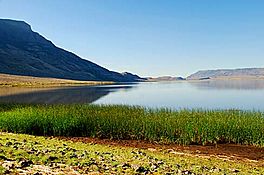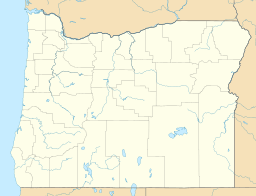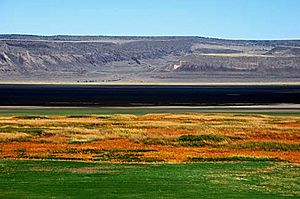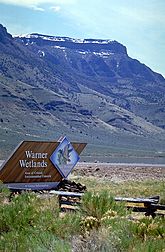Hart Lake (Oregon) facts for kids
Quick facts for kids Hart Lake |
|
|---|---|

North shore of Hart Lake
|
|
| Location | Lake County, Oregon, US |
| Coordinates | 42°25′12″N 119°50′42″W / 42.420°N 119.845°W |
| Type | Natural endorheic lake |
| Primary inflows | Crump Lake overflow and Honey Creek |
| Catchment area | 1,094 square miles (2,830 km2) |
| Max. length | 6.5 mi (10.5 km) |
| Max. width | 2.0 mi (3.2 km) |
| Surface area | 7,324 acres (29.64 km2) |
| Average depth | 5 ft (1.5 m) |
| Max. depth | 11 ft (3.4 m) |
| Water volume | 39,427 acre-feet (48,632,000 m3) |
| Residence time | 6 months |
| Shore length1 | 20.7 mi (33.3 km) |
| Surface elevation | 4,473 ft (1,363 m) |
| 1 Shore length is not a well-defined measure. | |
Hart Lake is a shallow lake located in the Warner Valley in eastern Lake County, Oregon, United States. It's a natural lake that covers about 7,324 acres (29.64 km²). Hart Lake is special because it has the most steady water level among the lakes in the Warner Lakes chain.
The lake got its name from a heart-shaped brand used by an early cattle ranch near the lake. A lot of the land around Hart Lake is managed by the Bureau of Land Management (BLM) and the United States Fish and Wildlife Service (FWS). This area, including the lake and its surrounding wetlands, is home to many different birds and other animals. People enjoy visiting Hart Lake for activities like hunting, fishing, bird watching, and boating.
Contents
About Hart Lake
Hart Lake is found in the Warner Valley in south-central Oregon. It is about 6.5 miles (10.5 km) long and 2 miles (3.2 km) wide. The Warner Valley itself is about 60 miles (97 km) long and 8 miles (13 km) wide.
This valley is an alluvial basin, which means it was formed by water depositing soil and rocks. Long ago, during the Pleistocene epoch (the Ice Age), a single large lake covered the entire valley floor. Today, what's left are several lakes, including Hart Lake, which are known as the Warner Lakes. These lakes are endorheic, meaning they don't have an outflow to the ocean.
Water Levels and Clarity

Hart Lake is quite shallow, with an average depth of 5 feet (1.5 m) and a maximum depth of 11 feet (3.4 m). The deepest part of the lake is at its northern end.
The lake gets water from two main sources: overflow from Crump Lake to the south and a steady flow from Honey Creek. Because of Honey Creek, Hart Lake's water level stays more stable than other lakes in the Warner chain. Any extra water during high levels flows into Anderson Lake, which is just north of Hart Lake.
The water in Hart Lake can look cloudy. This is because the shallow bottom allows waves to stir up tiny particles. Even though the water might look murky, it has a lot of nutrients. This means the lake is very productive, supporting a lot of life.
Wildlife and Nature
Hart Lake offers a special habitat for many plants and animals. The eastern shore of the lake is bordered by the slopes of Hart Mountain. This area is typical high desert land, with plants like big sagebrush and desert grasses.
To the north, south, and west of the lake, you'll find meadows and marshlands. These areas are filled with marsh grasses, willow trees, cottonwood trees, choke cherry bushes, and wild roses. Many different mammals, birds, and fish live here.
Fish Species
Hart Lake is home to several native fish species, including the Warner sucker, tui chub, and Great Basin redband trout. Honey Creek also has populations of these fish. These stream fish help to repopulate the lake after long dry periods.
Other fish, like rainbow trout, crappie, smallmouth bass, and bullhead catfish, have been introduced to the lake. These non-native fish can sometimes make it harder for the native species to survive. Because of this, the Warner sucker is considered a threatened species. In 1996, only about 493 adult Warner suckers were estimated to be in Hart Lake. To help protect these fish, the Fish and Wildlife Service created a recovery plan in 1998.
Mammals and Birds
Around Hart Lake, you can find 42 different kinds of mammals. Common mammals living near the lake's shoreline and in the marshes include raccoons, striped skunks, and muskrats.
The area is also a popular spot for birds, with 264 different species either living there or stopping during their migrations. Birds that nest near the lake include sandhill cranes, American white pelicans, double-crested cormorants, and many types of ducks and terns. You might also see white-faced ibis, great white egrets, great blue herons, and American avocets in the marshes.
North of Hart Lake, at the Warner Wetlands Interpretive Site, there are special spots to watch birds. Here, you can often see American bitterns, black-necked stilts, cinnamon teal, tundra swans, and different kinds of swallows.
In the meadows and marshes, summer brings birds like dusky flycatchers, yellow warblers, and house wrens. Larger birds of prey, such as great horned owls, turkey vultures, prairie falcons, red-tailed hawks, and even golden eagles and bald eagles, are also found in the Hart Lake area.
History of Hart Lake
Native Americans lived in the Warner Valley for thousands of years before European explorers arrived. They left behind petroglyphs (rock carvings) along the eastern shore of Hart Lake. Some of these carvings are believed to be as old as 12,000 years. The Greaser Petroglyph Site, which is southeast of Hart Lake, is a recognized historical place.
In December 1843, Captain John C. Frémont explored the Warner Valley. His group camped near Hart Lake on Christmas Day. Because of this, Fremont named the valley "Christmas Valley" and the lake "Christmas Lake." However, early mapmakers mistakenly put Christmas Valley in the wrong place on their maps.
In 1867, General George Crook decided to build a fort in the Warner Valley. To help his wagons cross the wet areas, he had a bridge built between Hart Lake and Crump Lake. This structure, known as the Stone Bridge, is also listed as a historic place.
The lake is named after the heart-shaped brand used by the Wilson and Alexander cattle ranch. This ranch was started near Hart Lake before 1878. Later, much of the private land near Hart Lake became part of the "7T Ranch," owned by Dr. Bernard Daly. By 1916, this ranch covered more than 7,000 acres (28 km²) north and west of Hart Lake.
Over time, water from Honey Creek was used for irrigation by ranchers. By the 1930s, these irrigation canals significantly reduced the amount of water flowing into Hart Lake. During droughts, the entire flow of fresh water was sometimes diverted, causing the lake's water level to drop. These canals also made it hard for fish to move between the lake and Honey Creek. In 1950, a dike was built at the north end of the lake to help it hold more water.
In the late 1980s and early 1990s, the Warner Valley faced a long drought. In 1992, Hart Lake completely dried up. Before this happened, the Fish and Wildlife Service moved some Warner suckers to a temporary safe place. When the drought ended, these fish were returned to the lake. In 1998, the FWS created a plan to help recover threatened fish species in the Warner Lakes.
Fun Activities at Hart Lake
Most of the land south and east of Hart Lake is privately owned. However, the Bureau of Land Management manages the Warner Wetlands, which are north of the lake. Also, the land along the east shore is part of the Hart Mountain National Antelope Refuge, managed by the United States Fish and Wildlife Service.
These public lands offer many chances for outdoor fun. You can go hunting, fishing, bird watching, boating, and camping. However, some activities depend on how much water is in the Warner Lakes, which can change a lot.
Because Hart Lake usually has a stable water level, it's often a good place for fishing and boating. There aren't any official campgrounds right next to Hart Lake, but you can camp in many spots on the public lands nearby. There's also a day-use area at the north end of Hart Lake called Hart Bar. North of Hart Lake, at the Warner Wetlands Interpretive Site, you'll find public restrooms, picnic tables, and hiking trails.





